The 'Book Review
Boost Speed with a Hybrid Drive, New MacBook Air Benchmarked, First SSD Upgrade for New MBA, and More
This Week's MacBook, PowerBook, and iBook News
Compiled by Charles Moore and edited by Dan Knight - 2010.10.29
General Apple and Mac desktops is covered in The Mac News Review. iPad, iPod, iPhone, and Apple TV news is covered in The iOS News Review. All prices are in US dollars unless otherwise noted.
News & Opinion
- Boost Your MacBook's Speed with a Hybrid Drive
- 15" and 17" MacBook Pros Get a 2.8 GHz BTO Option
- Why Apple Stuck with Core 2 Duo for the New MacBook Air
- Steve Jobs Is Wrong About the MacBook Air and DVD Drives
- How to Install Windows 7 on a MacBook Air
- Should Apple's Next MacBook Be an $800 Price Leader?
- MacBook Air vs. iPad Smackdown: Which Is Best for You?
- Did the New MacBook Air Just Crush the iPad?
- $670 Alternative to MacBook Air: iPad with Toccata Keyboard
- 3 Ways to Overcome the 2010 MacBook Air's Lack of a Backlit Keyboard
Reviews
- iFixit's 11" MacBook Air Teardown
- Primate Labs Posts New MacBook Air Benchmarks
- Macworld Benchmarks 'Ultimately Upgraded' MacBook Airs
- AnandTech Thoroughly Reviews 2010 MacBook Air
- Inside the New MacBook Air's Screen
Products & Services
Bargain 'Books
News & Opinion
Boost Your MacBook's Speed with a Hybrid Drive
Earlier this week, Seagate CEO Steve Luczo challenged Steve Jobs' assertion that SSDs are the future of laptop computing (second link below), contending that hybrid hard drives - such as his company's Momentus XT - are a better alternative, offering what Luczo claims to be basically the features and function of SSD at more hard drive-like cost and capacity, since hybrids use flash memory more as a cache than as the main storage medium.
Macworld's Rob Griffiths and Kirk McElhearn note that SSDs have no moving parts, offer incredible access speed, and can make a huge difference in the performance of your computer but are capacity-restricted and quite expensive. For example, substituting a standard 320 GB hard drive in a $1,499 13" MacBook Pro with a 512 GB SSD will drain your wallet by an extra $1,400, nearly equaling the price of the machine itself.
However, Seagate's Momentus XT 2.5" hard drive, which combines a 4 GB SSD with a standard 500 GB hard drive, can be had for a street price as low as $114.99 (see Amazon.com link below).
However, they observe that while hybrid drives promise a bit of the best of both worlds - SSD speed with traditional hard drive costs - you won't get anywhere near the speed boost you would with a full SSD, but the price premium for the speed boost that you do get is very modest.
Griffiths and Kirk McElhearn tested the Momentus XT hybrid drive in a mid-2010 2.66 GHz 15" MacBook Pro and found the hybrid notably faster than the stock drive that came with the machine, but still well-short of full SSD performance. They conclude that Seagate's hybrid drive seems like a great compromise for budget-conscious users.
They also text a Mac mini with a Seagate Momentus XT drive, and it reduced startup time by 40% compared with the stock 5400 rpm hard drive.
Link: Boost
Your MacBook's Speed with a Hybrid Drive
Link:
Seagate Technology PLC F1Q2011 Results - Earnings Call
Transcript
Link: Seagate
Momentus XT Drives from $100 (shipped) at Amazon.com
15" and 17" MacBook Pros Get a 2.8 GHz BTO Option
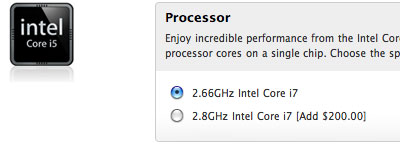 All but eclipsed in the excitement over the new MacBook
Air release last week was Apple's quietly adding a faster CPU option
for the 15" and 17" MacBook Pro models.
All but eclipsed in the excitement over the new MacBook
Air release last week was Apple's quietly adding a faster CPU option
for the 15" and 17" MacBook Pro models.
Both machines now have a new Build to Order option to upgrade from the previous high-end 2.66 GHz Core i7 chip to a 2.8 GHz Core i7 for an extra $200 (for the 15" 2.66 GHz model) or $400 (for the 17" Core i5 2.53 GHz MacBook Pro).
That seems a bit steep for such a modest (5%) bump on what what are already exceedingly fast computers, but the configuration button is there if you want to exercise that option.
Link: 15" MacBook Pro at the
Apple Store
Link: 17"
MacBook Pro at the Apple Store
Why Apple Stuck with Core 2 Duo for the New MacBook Air
Ars Technica's Chris Foresman notes that if you were hoping for enough CPU muscle in the new MacBook Air models to keep a bunch of Flash-addled webpages from bringing the portable to its knees, you'll be sorely disappointed that the Intel Core 2 Duo is still used in the new MacBook Air models, with the 11" MacBook Air trailing its predecessor in clock speed, while the 13" model hasn't changed CPU speed at all.
The explanation?
Foresman observed that the multicore GPU in Nvidia's GeForce 320M integrated graphics processor unit handily spanks Intel's HD GPU in the Core i-series processors, and the Nvidia chipset is also compatible with OpenCL, which Intel doesn't yet support in its built-in GPUs. Apple's argument is that the greater graphics power of the 320M is more important than more raw CPU processing power in smaller laptops, which is why the 13" MacBook Pro update comes with Core 2 Duo chips - and similar logic has been applied to the new MacBook Airs. Intel has thus far refused to license Core "i" silicon for use with Nvidia's graphics chipsets.
Foresman also explains why the 11.6" MacBook Air can only be had with 1.4 GHz or 1.6 GHz clock speed Core 2 Duos, while the larger 13" Air gets somewhat faster 1.86 GHz or 2.13 GHz CPUs. The reason is the chip's thermal profiles. The 1.4 GHz and 1.6 GHz units draw a cool-running 10 watts, while it's 17w (still quite respectable by today's torrid standards) for the 1.86 GHz or 2.13 GHz chips, which have more breathing room to cool in the 13-incher's larger enclosure.
Link: Why Apple Saddled the MacBook Air with 'Gimped' CPUs
Steve Jobs Is Wrong About the MacBook Air and DVD Drives
ITworld's Ryan Faas contends that Apple and netbook manufacturers have proved optical drives aren't critical, but says the technology is not ready to be buried just yet, even though the new MacBook Air ships with an install/restore "disk" on a bootable flash drive instead of a DVD.
Faas acknowledges that in many instances he can download software and install it without purchasing a box containing a CD or DVD that may never be used after installation, and that in the age of portable music players like the iPod, we don't really need CDs, and indeed are entering the age of streaming media for our computers and Internet direct to our TVs.
That still leaves emergency restore and diagnostic tools, (although some of them are migrating to flash and external hard drives), so there are are still reasons that computers need optical drive support.
Faas thinks the affirmative, for the near-term at least, noting that there are still a greater number of DVD/Blu-ray only titles than titles you can watch instantly via streaming, and some large software packages (Adobe Creative Suite comes to mind) that are so bulky that downloading them, while possible, is a challenging prospect even over broadband connection.
Editor's note: Since the MacBook Air finally has two USB ports, it should be relatively trivial to create your own bootable USB flash drive from the install/restore drive and then install your favorite utilities. 32 GB flash drives are available for the same $80 price as Apple's external SuperDrive. dk
Link: Why Steve Jobs Is Wrong About the MacBook Air and DVD Drives
How to Install Windows 7 on a MacBook Air
Cnet's Dong Ngo has posted a tutorial on how to install Windows 7 on a MacBook Air from a USB flash drive, obviating the necessity of buying an optional external optical drive for the Air, at least for that purpose.
Ngo says that all you'll need is a computer running Windows 7 with a working DVD drive, a 4 GB or larger USB flash drive, a Windows 7 installation DVD, and about an hour of free time.
Link: Install Win 7 on MacBook Air from a USB Drive
Should Apple's Next MacBook Be an $800 Price Leader?
The Apple Blog's Darrell Etherington thinks the MacBook Air represents a bold move forward in mobile computing with its flash storage and no compelling need for an optical drive, but he contends that Apple's greatest achievement with the Air - its defining feature that will have the strongest influence on Apple's other notebooks - is the Air's entry-level price, with the base 11.6" MacBook Air listing at $999, the same as the consumer MacBook.
Etherington suggests that the MacBook is due for a refresh and that a new MacBook should arrive by spring 2011 at the absolute latest, noting that Apple has little to gain by pitting two $000 laptops against each other. He anticipates a new, lower price point for the next of the MacBook iteration, noting that with component price drops and advances in manufacturing efficiency, there should few barriers to Apple offering a $799 MacBook, thereby opening Mac laptop ownership to a whole new tier of both consumers and price-sensitive enterprise and institutional users who've been tuning Mac laptops out up to now based on price.
Editor's note: That would also mean just a $200 difference in price between the Mac mini and the MacBook, which could bode well for a price reduction on the tiny desktop as well. dk
Link: Should Apple's Next MacBook Be an $800 Price Leader?
MacBook Air vs. iPad Smackdown: Which Is Best for You?
PCWorld's Ian Paul says Apple's 11" MacBook Air may create a conundrum for prospective Mac owners: Should they buy a petite Apple laptop or an iPad?
When Apple launched the Air, it said it was a hybrid device combining the best aspects of the MacBook with the iPad. Just like Apple's tablet device, the Air has flash storage and no optical or hard drive. But like previous versions of the Air, the new computer runs Mac OS X and has a laptop form factor.
If you had to pick just one device and you specifically wanted an Apple device for travel or use at home, which one would you choose?
Link: MacBook Air vs. iPad Smackdown: Which Is Best for You?
Did the New MacBook Air Just Crush the iPad?
TCGeeks says:
"I just got one of the new 11.6" MacBook Air laptops. So far I love it. But there's an issue. The issue is that it's the perfect solution that I was looking for when I got my iPad. It's small, light, great battery life, keyboard, and soon it will have the Mac App Store. Now I have to ask myself and my readers what choice they would make now that we have this new MacBook Air to choose from."
Link: Did the New MacBook Air Just Crush the iPad?
$670 Alternative to MacBook Air: iPad with Toccata Keyboard
Fast Company's Chris Taylor proposes an iPad paired with Aussie peripherals-maker Padacs $70 Toccata keyboard case as a budget alternative to the new MacBook Air, which he says, based on his own such rig, gives you an ultralight Apple notebook with an entirely solid-state hard drive, a battery that charges fast and lasts for so long reports: merely has to think about it (just plugs it in every other night), and a portable 9.7 in. screen that conveniently detaches to be used in pure tablet mode, and cost in total, just $670.
Taylor notes that like the best products in Apple's ecosystem, the Toccata "just works," connecting automatically via Bluetooth when you press any key, and switching itself off when not in use, providing 45 hours of runtime, and recharging via USB.
He reports that the rubberized silicon keys are soft yet solid enough to take some finger-tapping punishment, and they make a beautiful sound when you're in a typing flow, like rain on a window pane, and even though it's not a full-sized keyboard, it's surprisingly pleasant to type on, including a row of F-keys, a volume control, music controls, and a button that takes you back to the iPad home screen, although one sour note is an oddly-placed single and double quote key.
Taylor also likes that the iPad/Toccata combo runs cool and makes it possible to write virtually anywhere, and elicits a lot of admiring attention from computer-toting cafe patrons.
He concedes that the iPad doesn't do everything power users need, and says he still uses his MacBook Pro for serious editing work, but contends that for writers the Toccata case vastly improves the iPad's functionality.
As a limited-time incentive, Padacs is offering free shipping for its US customers to celebrate the launch of Padacs in North America. Padacs currently ships its products throughout the US, Canada, and Australia.
Link: The $670
Alternative to MacBook Air: iPad, Toccata Keyboard
Link: Padacs iPad
Cases & Stands
3 Ways to Overcome the 2010 MacBook Air's Lack of a Backlit Keyboard
Bare Feats' rob-ART Morgan offers three tongue-in-cheek solutions to the omission of keyboard backlighting from the new MacBook Air, noting that he's having some fun at Apple's expense, but asking "seriously, why did Apple drop this very popular feature from the 2010 MacBook Air?" and suggesting that at the very least, Apple should offer it as a CTO option.
Link: Three Ways to Overcome the Lack of a Backlit Keyboard on the 2010 MacBook Air
Reviews
iFixit's 11" MacBook Air Teardown
iFixit's Miro Djuric says:
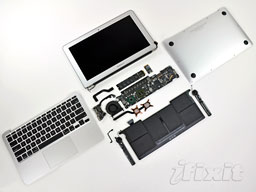 "The new MacBook Air is an exercise of proprietary engineering.
While you can easily access everything once you remove the proprietary
screws, you can't really replace any component with an off-the-shelf
part, unless you source it from Apple or someone involved in
Apple-based repair ((*)cough(*)). Most components - RAM included - are
soldered to the logic board, preventing them from being replaced. We
definitely recommend users to buy the 4 GB RAM version of the Air,
as the paltry 2 GB already borders on obsolete by today's
standards.
"The new MacBook Air is an exercise of proprietary engineering.
While you can easily access everything once you remove the proprietary
screws, you can't really replace any component with an off-the-shelf
part, unless you source it from Apple or someone involved in
Apple-based repair ((*)cough(*)). Most components - RAM included - are
soldered to the logic board, preventing them from being replaced. We
definitely recommend users to buy the 4 GB RAM version of the Air,
as the paltry 2 GB already borders on obsolete by today's
standards.
"The one standout in this proprietary sea is the 64 GB SSD. It's not locked down like the rest of the components, although it is a very slim and unusual form factor (for a hard drive). It's attached to the logic board with what appears to be a new mini-SATA (mSATA) connector, which brings hope to super-slim-laptop-hackers all across the globe. This may enable some crafty tinkerers to rig a larger drive inside the Air, provided they can fit everything within the tight confines of the .68" thick case.
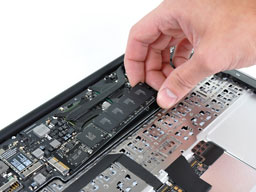 "We gave 11" MacBook Air a not-so-good
repairability score of 4 out of 10, with 10 being easiest to repair.
Simply put, a plethora of proprietary parts prevents people from
painlessly fixing their machines."
"We gave 11" MacBook Air a not-so-good
repairability score of 4 out of 10, with 10 being easiest to repair.
Simply put, a plethora of proprietary parts prevents people from
painlessly fixing their machines."
Teardown highlights:
- The flip-open port door has been scrapped and the IR sensor and sleep LED are gone. In exchange, the new model manages to fit an extra USB 2.0 port along its right edge.
- Apple apparently doesn't want you inside this thing. They decided to use proprietary 5-point security Torx screws to attach the lower case. Once inside, the Air is held together with more normal 6-point T5 and T8 Torx screws.
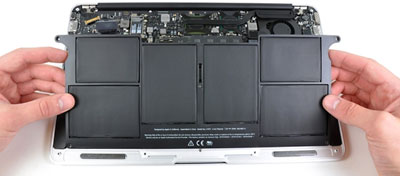 The battery is comprised of six individual
lithium-polymer cells, which combine to form a 35 Watt-hour
battery.
The battery is comprised of six individual
lithium-polymer cells, which combine to form a 35 Watt-hour
battery.- Although in a different form factor, the new MacBook Air uses the same Broadcom BCM943224 WiFi/Bluetooth chip as the current lineup of MacBook Pros.
- The back of the trackpad has a Broadcom BCM5976A0K chip on it, likely responsible for the multitouch capabilities of the the trackpad.
- The 11.6" MacBook Air features a resolution of 1366 x 768. That's a few more pixels and noticeably more widescreen (16:9 vs. 16:10) than the 1280 x 800 resolution of previous Air models. In a welcome improvement, Apple has substantially enhanced the rigidity of the display assembly.
"The new MacBook Air is a tidy little package, but we wish Apple would stop intentionally preventing users from upgrading and repairing their devices."
Link: MacBook Air 11.6" Teardown
Primate Labs Posts New MacBook Air Benchmarks
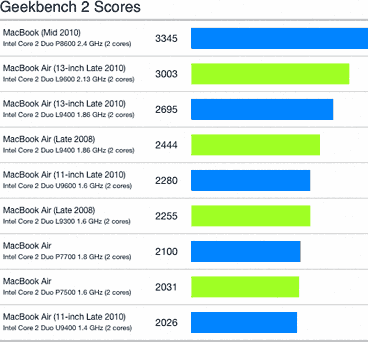 Primate
Labs' John Poole has done an abbreviated performance comparison of the
new MacBook Airs that Apple released last week using Geekbench 2 scores
from the Geekbench Result Browser and the latest 13" MacBook Pro models
as his reference point of comparison, deducing that the smallest
MacBook Pro, is the machine most folks will be comparing the new Airs
against.
Primate
Labs' John Poole has done an abbreviated performance comparison of the
new MacBook Airs that Apple released last week using Geekbench 2 scores
from the Geekbench Result Browser and the latest 13" MacBook Pro models
as his reference point of comparison, deducing that the smallest
MacBook Pro, is the machine most folks will be comparing the new Airs
against.
Geekbench 2 scores (which measure only processor and memory performance) tallied range from a high of 3655 for the 2.66 GHz 13" MacBook Pro, to a low of 2026 for the new 1.4 GHz 11.6" MacBook Air among the laptop machines.
Low End Mac has reduced the original graph to only show MacBook Air scores along with the current consumer MacBook.
Link: MacBook Air Benchmarks (Late 2010)
Macworld Benchmarks 'Ultimately Upgraded' MacBook Airs
Macworld's James Galbraith reports that the standard 2010 MacBook Air models offer impressive improvements in both design and performance when compared to previous MacBook Airs. But with just 2 GB of RAM and the slowest Intel Core 2 Duo processors in the entire Mac lineup, Macworld's editors were interested in putting some of the build-to-order options to the test.
Galbraith notes that the ultimate 11" MacBook Air takes the $1,199 MacBook Air and adds 2 GB of RAM (4 GB of RAM total) and bumps the processor from the stock 1.4 GHz to 1.6 GHz, bringing its cost to $1,399, while the ultimate 13" MacBook Air configuration starts with the $1,599 version and, after the RAM gets bumped to 4 GB and the processor gets a boost from 1.86 GHz to 2.13 GHz, sells for $1,799.
You can spend more than that on Apple's configuration page by adding an external optical drive ($79) and selection of I/O adapter dongles.
Macworld found that the 13" 2.4 GHz MacBook is still 5% faster overall than the 1.6 GHz 11" MacBook Air - but the ultimate 13" 2.13 GHz Air is 20% faster than the MacBook.
Link: 2010 MacBook Air: Ultimate-Edition Lab Tests
AnandTech Thoroughly Reviews 2010 MacBook Air
AnandTech reviews are probably unsurpassed in their thoroughness, and editors Anand Lal Shimpi & Vivek Gowri have trained their formidable analytical skills on the new MacBook Air models. I won't even attempt to summarize the contents of this comprehensively ranging review except to say that all bases are covered. The reviewers do say that Apple won't call the Air a netbook, but that's exactly what the 11.6 inch MacBook Air is: a netbook with much better hardware. You get a full sized keyboard, an old but faster-than-Atom processor and a great screen.
Link: Apple's 2010 MacBook Air (11 & 13 inch) Thoroughly Reviewed
Inside the New MacBook Air's Screen
ZDNet blogger Jason D. O'Grady talks to Tech Restore's CEO Shannon Jean, who sheds some light on the hoops that Apple jumped through to save weight and thickness on its thinnest notebook ever.
TechRestore is so far the only vendor offering a matte finish screen replacement for the new MacBook Air's glossy screen, and Jean notes that getting inside the Air's screen bezel is more difficult than with previous models, since the screen is paper thin and not inside a housing like the traditional screens, but rather in layers, a mode Jean says he doesn't think has ever been used before in a laptop.
Photos of screen removal process are included.
Link: Inside the New MacBook Air's Screen
Products & Services
First SSD Upgrade Kits for New MacBook Air Boast 30% Performance Increase
PR: Who says the new Late 2010 MacBook Airs can't be upgraded? Taiwan-based PhotoFast Global Inc.'s new GM2 SFV1 Air Upgrade Kit for the latest MacBook Airs is claimed to offer a greater than 30% performance increase from the original configuration.
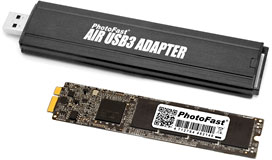 The new MacBook Air is ultraportable, offers good performance
and gorgeous industrial design. But PhotoFast have decided to offer
even more - an alternative SSD choice with 256 GB capacity in the 11.6"
MacBook Air is now possible.
The new MacBook Air is ultraportable, offers good performance
and gorgeous industrial design. But PhotoFast have decided to offer
even more - an alternative SSD choice with 256 GB capacity in the 11.6"
MacBook Air is now possible.
SandForce is a well-known SSD controller manufacturer with which PhotoFast has a solid partnership. "Creating a whole new form factor SSD in the very limited time was quite a challenge. Thanks to support from SandForce, we finally made it," says chief engineer Eddie Wang.
There's one more thing, the SSD to USB 3.0 adapter. Considering system switching or cloning to new drive, PhotoFast added a handy adapter with an aluminum housing which makes upgrading even easier, allowing you to recycle your pulled OEM SSD as a portable storage device.
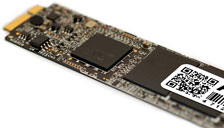 GM2 SFV1 Air Features:
GM2 SFV1 Air Features:
- Above 30% performance increase from original
- USB 3.0 adapter for system clone, and for spare SSD to act as portable storage device.
- 256 GB SSD option for 11.6" MBA
- The kit will be available in 64 GB, 128 GB, and 256 GB capacities.
Physical Specifications
- Weight: 15g
- Dimensions: 108.5 x 29.0 x 1.6 mm
- Controller: SandForce SF-1200
- Host Bus Interface: Customized SATA interface
- Capacity: 64 GB, 128 GB, 256 GB
- High Performance
- Support: NAND Flash MLC flash supported
- Performance:
- Read: Seq. 250 MB/s, Random 50 MB/s
- Write: Seq. 250 MB/s, Random 30 MB/s
- Environmental
- Operating Temperature: 0C ~ 70C
- Storage Temperature: -25C ~ 85C
- Vibration Operation: 20G Peak
- Storage: 20G Peak
- Shock Operation: 1500G
- Storage: 1500G
No prices or release date are cited. PhotoFast say they are seeking distributors outside of the Japan region.
Link: PhotoFast GM2 SFV1 Air Upgrade Kit for New MacBook Air
Bargain 'Books
For deals on current and discontinued 'Books, see our 13" MacBook and MacBook Pro, MacBook Air, 13" MacBook Pro, 15" MacBook Pro, 17" MacBook Pro, 12" PowerBook G4, 15" PowerBook G4, 17" PowerBook G4, titanium PowerBook G4, iBook G4, PowerBook G3, and iBook G3 deals.
We also track iPad, iPhone, iPod touch, iPod classic, iPod nano, and iPod shuffle deals.
Join us on Facebook, follow us on Twitter or Google+, or subscribe to our RSS news feed
Links for the Day
- Mac of the Day: 15" 'TiBook' PowerBook G4, (2001.01.09. A new 1" thin PowerBook design with a titanium case and 15" widescreen display.)
- Support Low End Mac
Recent Content
About LEM Support Usage Privacy Contact
Follow Low End Mac on Twitter
Join Low End Mac on Facebook
Favorite Sites
MacSurfer
Cult of Mac
Shrine of Apple
MacInTouch
MyAppleMenu
InfoMac
The Mac Observer
Accelerate Your Mac
RetroMacCast
The Vintage Mac Museum
Deal Brothers
DealMac
Mac2Sell
Mac Driver Museum
JAG's House
System 6 Heaven
System 7 Today
the pickle's Low-End Mac FAQ
Affiliates
Amazon.com
The iTunes Store
PC Connection Express
Macgo Blu-ray Player
Parallels Desktop for Mac
eBay

